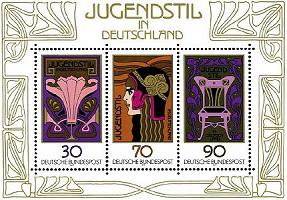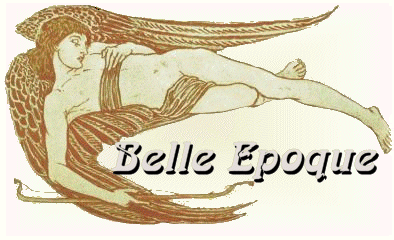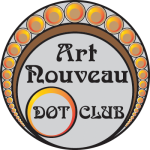The Belle Epoque in Europe
Liberty Stile/Art Nouveau

In general, the term Art Nouveau comprises all artistic currents of the turn of the XIX/XXth century creating something new by turning away from the traditional art style. Thus, on one hand, it means an epoch in history of art covering about 30 years; it begins around 1880 and ends around 1910. Most countries and languages use the term Art Nouveau for these modern art styles. It comes from the Parisian art shop "La Maison de l'Art Nouveau" (The House of the New Art) of Samuel Bing who specialized in the new art. The German term Jugendstil (style of the Youth) comes from the Munich magazine "Die Jugend" (The Youth). The customary Italian term stile libero resp. the English term Style Liberty comes from the name of a London department store which was not only constructed in the new style but there, expositions of modern art also took place regularly. Especially in Austria and in the other countries of the former Austro-Hungarian monarchy, the term Secession Style is very customary, derived from the Vienna Secession; in this term, the (lat.) secessio, the separation, the original intention of the artists to emphasize the difference between them and the traditional cultural activities, is still living.
The term Art Nouveau reaches therefore from the early beginning of the English Arts-and-Crafts movement until buildings already showing a preliminary stage of Art Deco or Bauhaus, such as e. g. the Palais Stoclet in Brussels or the business house Goldman & Salatsch on the Michaelerplatz in Vienna. The Art Nouveau style did not arise from influences of the European history but it was of an experimental character, resulting from the desire of breaking with traditions. It can be divided in two main streams:
The most widespread variant is for sure the so-called floral Art Nouveau, a mixture of baroque, oriental and classical elements, in parts strongly influenced by Japanese art, expressing the break with traditional forms, on one hand reflecting the spirit of the Belle Epoque and influencing it at the same time. A characteristic for the floral type is the absence of any straight line and any right angle. The lines seem to bend infinitely, the forms swell and contract. It is the nature serving as model: Being a decorative art by origin, the artists preferred ornamental structures imitating flowers and leaves. Most works of the Art Nouveau resemble to living organisms. The curved vegetable lines create an impression of lightness and charm. Many artists of the Art Nouveau used these curved forms of vegetation: The most favourite flowers were the lily, the iris and the orchid, but they also used oriental subjects such as palm branches, papyruses, seaweed. Stylistically represented were animals, too, especially insects and birds abounding in colours: dragonflies, peacocks, swallows, swans. Moreover, the artists appreciated the female body as a decorative element, especially with long open hair, flowing in long and soft waves. The basic elements of the Art Nouveau are the colour, the glass and the light, for interior decoration additionally soft wood of honey colour, in the architecture the iron. The combination of these elements creates an effect of fantasy, lightness, sometimes even instability. This new style, sometimes exaggerated, excessive, was the vivid contrast to the works even if much decorated, yet gloomy and ponderous of the preceding era. It can be found on a vast corridor through the European continent from West to East, from Paris, Nancy and Brussels via Dresden and Munich, Prague and Budapest until St. Petersburg and Riga. Important exponents of this variant among countless others were Hector Guimard, Eugène Vallin, Victor Horta, Henry van de Velde or August Endell.
A completely different variant in its appearance is the so-called geometric Art Nouveau. It is characterized by mostly severe and straight lines as well as clear and often symmetric constructions and openings. Also, colours are much less used; sometimes the simple black and white contrast is preferred. The main exponent of this variant in its uncompromisingly style was the Glaswegian Charles Rennie Mackintosh whose works were shown in Vienna in 1900 having an enormous influence on the members of the Secession, especially on Otto Wagner, so that the geometric Art Nouveau can be found in a less severe variant in Vienna and the Wiener Werkstätte (Vienna Workshop) rather than the floral Art Nouveau.
A third variant is joined with one name alone: Antoni Gaudí. Quite evidently arisen from the floral Art Nouveau, his style is dominated unmistakably by the Moorish history of Spain. The Gaudí buildings in Barcelona often are dazzling colourful mosaics, many of them are made of natural stones; they have few even surfaces, but forms full of fantasy, exploring the boundaries of this style. Even a building like the gigantic church Sagrada Familia complies on the whole to these attributes. But Gaudí can create cool and severe constructions, too, as you can see inside the Colegio Teresiano.

